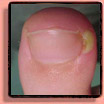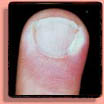Paronychia Fingernail & Toenail Disorders |
Find your Nail Disorder problem!
The most common nail disorders and nail diseases are:
Beau's Line - Black Toe Nail - Brittle Nails - Nail Clubbing - How to cure Nail Fungus - Nail Disorder - Nail Fungus - Infection - Koilonychia - Leukonychia - Onycholysis - Paronychia - Nail Pitting - Red Nails - Nail Ridges - Split Toe Nail - Nail Pitting - Toe Nail Fungus - Diabetes & Nails - Psoriasis Nails - Rheumatoid Nails - Nail Fungus Treatment - Nail Biting Remedies - Nail Biting Treatment - Toddlers & Nail Biting - Japanese Nail Art - Acrylic Nail Art - Artificial Nail Art
[ Read more about Nail Disorders ]
|
|
Browse the Nail Encyclopedia!
Major items in the Hand Research Nail Encyclopedia are:
The Psychology behind Nail Biting
Nail Diseases
Nail Disorders
Nail Products
Nail Art Resources
Discover the world of the nails:
[ The Hand Research Nail Encyclopedia ]
|
|
NAIL ENCYCLOPEDIA - FINGERNAIL NEWS
|
|
|
How to recognize Paronychia Nail Disorder?
The nail disease paronychia is an often tender bacterial or fungal infection where the nail and skin meet.
It can start suddenly (acute paronychia) or gradually (chronic paronychia).
Pus is usually present, along with gradual thickening and browning discoloration of the nail plate.
Paronychia around the entire nail is sometimes referred to as runaround paronychia.
Chronic paronychia is most often caused by a yeast infection of the soft tissues around the nail but can also be traced to a bacterial infection.
Individuals who work with their hands in water, such as health care workers and food processors, are quite prone to this type of infection.
Paronychia: Home & Medical Treatment.
SELF CARE AT HOME:
SECTION: NAIL DISORDERS
Care at home includes warm soaks in a mixture of 50% warm water and 50% liquid antibacterial soap 3-4 times daily for about 15 minutes.
This soaking should be done at the first sign of redness around the nail.
Usually, antibiotics are only prescribed if the infection involves more of the finger than around the nailbed.
It is important to follow up with your doctor in 24-48 hours to be sure that the infection is healing properly.
MEDICAL TREATMENT:
Most cases of acute paronychia should be treated with antibiotics such as cephalexin or dicloxacillin.
Topical antibiotics or anti-bacterial ointments do not effectively treat paronychia.
If there is pus or an abscess involved, the infection may need to be incised and drained.
Rarely, a portion of the nail may need to be removed.
Chronic paronychia is treated with topical antifungal medication such as ketoconazole cream.
A mild topical steroid like hydrocortisone may be added to the antifungal medication to help reduce inflammation.
Steroids should never be used alone on a chronic paronychia.



More:
PARONYCHIA
described in the Nail Tutor! - 2 - 3
|
|
© COPYRIGHT 2002-2017: |

